Hyundai Kona vs Mazda CX-30 – erot ja hinnat vertailussa
Kustannukset ja kulutus
Taloudellisuudessa on mielenkiintoisia eroja näiden kahden mallin välillä.
Hyundai Kona on hinnassa tuskin havaittava edullisempi – sen lähtöhinta on 26900 €, kun taas Mazda CX-30 maksaa 29400 €. Ero on noin 2540 €.
Myös polttoaineenkulutuksessa näkyy ero: Hyundai Kona kuluttaa 4.60 L ja on siten erottuva taloudellisempi kuin Mazda CX-30, jonka kulutus on 5.70 L. Ero on noin 1.10 L /100 km.
Moottori ja suorituskyky
Teho, vääntömomentti ja kiihtyvyys ovat autoharrastajien klassisia mittareita – ja erot tulevat tässä hyvin esiin.
Moottoritehossa Hyundai Kona on jonkin verran etulyöntiasemassa – 218 hv verrattuna 186 hv:een. Ero on noin 32 hv hv.
Kiihdytyksessä 0–100 km/h Hyundai Kona on melkein huomaamaton nopeampi – se saavuttaa 100 km/h ajassa 7.80 s, kun taas Mazda CX-30 tarvitsee 8.30 s. Ero on noin 0.50 s sekuntia.
Huippunopeudessa Hyundai Kona on vähäinen edellä – se yltää 210 km/h:een, kun taas Mazda CX-30 saavuttaa 204 km/h. Ero on noin 6 km/h.
Myös vääntömomentissa näkyy ero: Hyundai Kona vetää melkein huomaamaton voimakkaammin, 265 Nm verrattuna 240 Nm:een. Eroa on noin 25 Nm.
Tila ja käytännöllisyys
Perheauto vai arjen kumppani – kumpi tarjoaa enemmän tilaa, mukavuutta ja käytettävyyttä?
Istuimet: tarjoaa enemmän istumapaikkoja – vs. .
Omapainossa Hyundai Kona on tuskin havaittava kevyempi – 1370 kg verrattuna 1455 kg:een. Painoero on noin 85 kg.
Tavaratilan koossa Hyundai Kona tarjoaa vähäinen enemmän – 466 L verrattuna 430 L:een. Ero on noin 36 L.
Maksimikantavuudessa Mazda CX-30 pärjää kevyt paremmin – jopa 1406 L, noin 106 L enemmän kuin Hyundai Kona.
Kantavuudessa Mazda CX-30 on kevyt parempi – 496 kg verrattuna 490 kg:een. Ero on noin 6 kg.
Kuka voittaa vertailun?
Hyundai Kona osoittautuu olevan on ylivoimainen ja saa siksi tittelin DriveDuel Champion!
Tässä vertailussa Hyundai Kona on monipuolisempi kokonaisuus.
 @ Hyundai Motor Company
@ Hyundai Motor Company
Hyundai Kona
Kustannukset ja kulutus
Näytä yksityiskohtainen analyysi
Moottori ja suorituskyky
Näytä yksityiskohtainen analyysi
Mitat ja kori
Näytä yksityiskohtainen analyysi
Hyundai Kona
Hyundai Kona erottuu katukuvassa persoonallisilla muodoillaan ja rohkeilla yksityiskohdillaan, jotka tuovat piristystä perinteisten katumaasturien rivistöön. Se on käytännöllinen ja ketterä kaupunkiauto, joka tarjoaa mukavan ajettavuuden ja fiksun varustelutason ostajalle, joka haluaa tyyliä ilman turhaa ylpeilyä.
Tiedot @ Hyundai Motor Company
@ Hyundai Motor Company
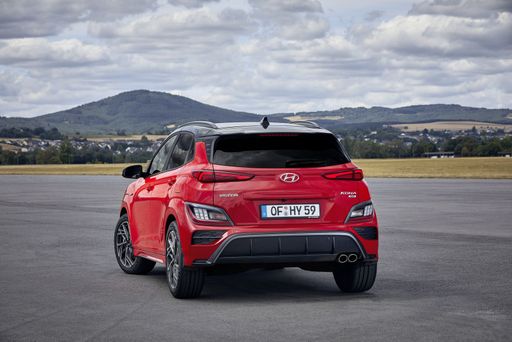 @ Hyundai Motor Company
@ Hyundai Motor Company
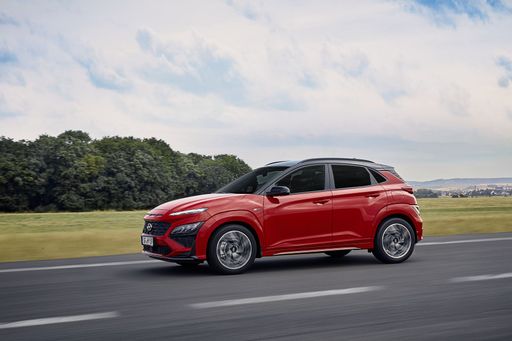 @ Hyundai Motor Company
@ Hyundai Motor Company
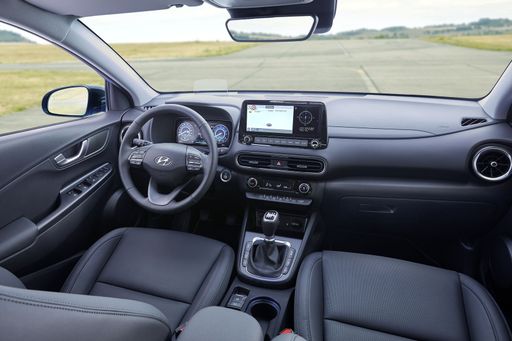 @ Hyundai Motor Company
@ Hyundai Motor Company
Mazda CX-30
Mazda CX-30 tuntuu ajossa ketterältä ja laadukkaalta, mikä tekee arkiajosta miellyttävän ilman turhaa prameilua. Sisätilat ovat hillityn tyylikkäät ja ohjaus innostava — pieni auto, joka osaa yllättää hyvällä ajotuntumalla.
Tiedot @ Mazda Motor Corporation
@ Mazda Motor Corporation
 @ Mazda Motor Corporation
@ Mazda Motor Corporation
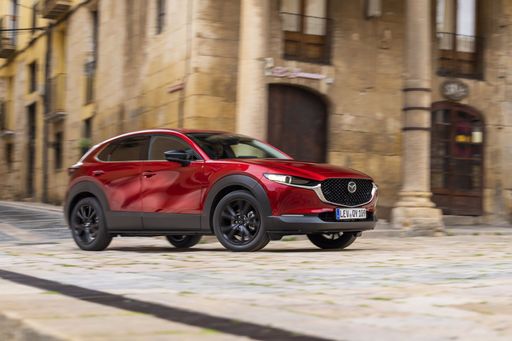 @ Mazda Motor Corporation
@ Mazda Motor Corporation
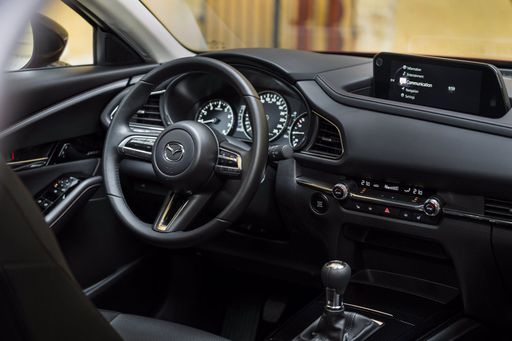 @ Mazda Motor Corporation
@ Mazda Motor Corporation
 @ Hyundai Motor Company
@ Hyundai Motor Company
|
 @ Mazda Motor Corporation
@ Mazda Motor Corporation
|
|
|
|
Kustannukset ja kulutus |
|
|---|---|
|
Hinta
26900 - 48500 €
|
Hinta
29400 - 42900 €
|
|
Kulutus L/100km
4.6 - 7 L
|
Kulutus L/100km
5.7 - 6.6 L
|
|
Kulutus kWh/100km
14.6 - 16.8 kWh
|
Kulutus kWh/100km
-
|
|
Sähköinen toimintasäde
377 - 514 km
|
Sähköinen toimintasäde
-
|
|
Akun kapasiteetti
1.3 - 65.4 kWh
|
Akun kapasiteetti
-
|
|
CO2
0 - 163 g/km
|
CO2
129 - 148 g/km
|
|
Polttoainesäiliön tilavuus
38 - 47 L
|
Polttoainesäiliön tilavuus
48 - 51 L
|
Mitat ja kori |
|
|---|---|
|
Kori
SUV
|
Kori
SUV
|
|
Istuimet
5
|
Istuimet
5
|
|
Ovet
5
|
Ovet
5
|
|
Omamassa
1370 - 1773 kg
|
Omamassa
1455 - 1587 kg
|
|
Tavaratila
466 L
|
Tavaratila
422 - 430 L
|
|
Pituus
4350 - 4385 mm
|
Pituus
4395 mm
|
|
Leveys
1825 mm
|
Leveys
1795 mm
|
|
Korkeus
1580 - 1585 mm
|
Korkeus
1540 mm
|
|
Maksimi tavaratila
1300 L
|
Maksimi tavaratila
1398 - 1406 L
|
|
Kantavuus
420 - 490 kg
|
Kantavuus
458 - 496 kg
|
Moottori ja suorituskyky |
|
|---|---|
|
Moottorityyppi
Sähkö, Bensiini, Täyshybridi
|
Moottorityyppi
Bensiini MHEV
|
|
Vaihteisto
Automaatti, Manuel
|
Vaihteisto
Manuel, Automaatti
|
|
Vaihteiston tyyppi
Alennusvaihteisto, Manuaalivaihteisto, Kaksoiskytkin automaatti
|
Vaihteiston tyyppi
Manuaalivaihteisto, Automaattivaihteisto
|
|
Vetotapa
Etuveto, Neliveto
|
Vetotapa
Etuveto, Neliveto
|
|
Teho hv
115 - 218 hv
|
Teho hv
140 - 186 hv
|
|
Kiihtyvyys 0-100 km/h
7.8 - 11.9 s
|
Kiihtyvyys 0-100 km/h
8.3 - 10.3 s
|
|
Huippunopeus
162 - 210 km/h
|
Huippunopeus
191 - 204 km/h
|
|
Vääntömomentti
200 - 265 Nm
|
Vääntömomentti
238 - 240 Nm
|
|
Sylinterien lukumäärä
3 - 4
|
Sylinterien lukumäärä
4
|
|
Teho kW
85 - 160 kW
|
Teho kW
103 - 137 kW
|
|
Iskutilavuus
998 - 1598 cm3
|
Iskutilavuus
1998 - 2488 cm3
|
Yleiset |
|
|---|---|
|
Mallivuosi
2024 - 2025
|
Mallivuosi
2025
|
|
CO2-tehokkuusluokka
A, D, C, E, F
|
CO2-tehokkuusluokka
D, E
|
|
Merkki
Hyundai
|
Merkki
Mazda
|
Onko Hyundai Kona saatavana eri vetotavoilla?
Saatavilla olevat vaihtoehdot: Etuveto tai Neliveto.
Näytetyt hinnat ja tiedot ovat arvioita, jotka perustuvat Saksan listahintoihin, ja voivat vaihdella maittain. Nämä tiedot eivät ole oikeudellisesti sitovia.
